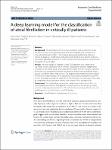Item Infomation
Full metadata record
| DC Field | Value | Language |
|---|---|---|
| dc.contributor.author | Brian, Chen | - |
| dc.contributor.author | David M., Maslove | - |
| dc.contributor.author | Jeffrey D., Curran | - |
| dc.date.accessioned | 2023-03-29T03:19:20Z | - |
| dc.date.available | 2023-03-29T03:19:20Z | - |
| dc.date.issued | 2023 | - |
| dc.identifier.uri | https://link.springer.com/article/10.1186/s40635-022-00490-3 | - |
| dc.identifier.uri | https://dlib.phenikaa-uni.edu.vn/handle/PNK/7259 | - |
| dc.description | CC BY | vi |
| dc.description.abstract | Atrial fibrillation (AF) is the most common cardiac arrhythmia in the intensive care unit and is associated with increased morbidity and mortality. New-onset atrial fibrillation (NOAF) is often initially paroxysmal and fleeting, making it difficult to diagnose, and therefore difficult to understand the true burden of disease. Automated algorithms to detect AF in the ICU have been advocated as a means to better quantify its true burden. | vi |
| dc.language.iso | en | vi |
| dc.publisher | Springer | vi |
| dc.subject | Atrial fibrillation | vi |
| dc.subject | New-onset atrial fibrillation | vi |
| dc.title | A deep learning model for the classification of atrial fibrillation in critically ill patients | vi |
| dc.type | Book | vi |
| Appears in Collections | ||
| OER- Y học- Điều dưỡng | ||
Files in This Item:

